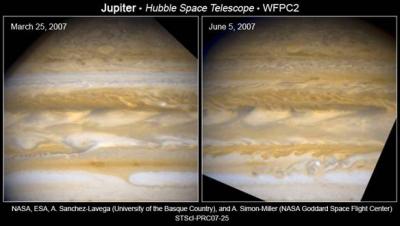02 July 2007

Fig (1)
Mighty Jupiter, the largest planet, has a turbulent atmosphere. NASA's Hubble Space Telescope (HST) recently conducted intriguing observations of remarkable changes in the Jovian atmosphere. HST's images reveal a rapid transformation in the shape and color of churning clouds in the planet's equatorial region.
Jupiter is characterized by colorful cloud bands that entirely shroud the planet. Lighter-hued areas mark regions where the atmospheric currents are ascending. They are known as zones. Dark-hued areas are regions where the currents flow downward. They are termed belts.
When these oppositely directed flows interact, storms occur. During the period 25 March and 5 June 2007, Hubble's Wide Field and Planetary Camera 2 (WFPC2) monitored entire bands of clouds changing color. There was an interchange of colors between zones and belts. Zones have darkened into belts, and belts lightened, transforming into zones. Cloud features also changed in shape and size.
In the left-hand image of figure 1, a thin band of white clouds is visible above Jupiter's equator. The white color indicates clouds at higher elevations in the Jovian atmosphere. In the image at right, the band's white hue has turned brown, showing clouds deep within the planet's atmosphere. The whole band appears to have merged with the one below it.
In the same cloud band above the equator, the small swirls in the left-hand image have morphed into larger wave-like features in the image at right. Dominating the band is a dark streak that resembles a snake. This serpent-like structure is actually a small break in the cloud deck, which permits a glance deep into the atmosphere.
Below the equatorial region, the brownish upside-down shark fin in the left-hand image disappears in the image at right. Brownish tongue-shaped clouds with a flow of white swirls below them appear in place.
Such planetwide upheavals are not uncommon in Jupiter, but this is the first time astronomers observe them with Hubble's superb resolution.
Further Reading
Hubble Snaps Baby Picture of Jupiter's "Red Spot Jr."
http://hubblesite.org/newscenter/archive/releases/2006/19/
Jupiter
http://www.nineplanets.org/jupiter.html
Aymen Mohamed Ibrahem
Senior Astronomy Specialist